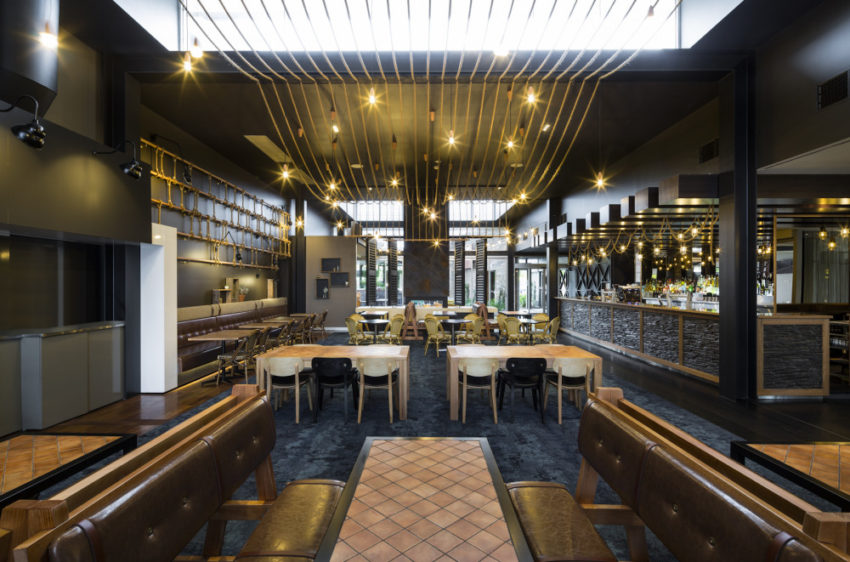Pub Nouveau: Studio Nine and the Art of Pub Design

A new generation of pub design is upon us. With four freshly fitted venues under their belt, Studio Nine Architects is at the forefront of this new wave of venue design.
“It is about the experience. What we’re trying to do is give people an experience they don’t have at home,” says Tony Zappia, a Director at the newly enhanced Studio Nine Architects. “One that they can feel comfortable with and one that they can relate to.”
He is speaking on his firm’s work redesigning and refitting four Adelaide pubs. It was two firms that worked on these pubs, Studio Nine and Abeo Design. They have now merged partly due to that string of successful collaborations. Studio Nine brought the architectural nous to the projects, while Abeo focussed on the all-important interior fit-out.

Light fittings at The Moseley (photo: David Sievers)
Zappia says both firms were successful in working together because they already had interweaving skill sets and philosophies as well as openness to criticism and change. While cooperation between separate design firms can sometimes be a fractious, somewhat ego-driven affair, the Studio Nine/Abeo collaborations were practically seamless.
“Our strengths are different, but our goals are exactly the same,” he says. “We might think and come from different directions, but part of our success is that we’re questioning everything we do, whether from an architectural standpoint or from the interior’s standpoint.”
The four pubs that brought the two firms together are all owned by the RD Jones group: The Gully Public House & Garden, Woodcroft Hotel, Holdfast Hotel (now known as ‘The Holdy’) and Moseley Bar & Kitchen in Glenelg. Studio Nine already had a longstanding relationship with the now-deceased RD Jones patriarch Robert Jones, and Abeo was brought into the loop by his daughter Danielle.

The Gully Public House and Garden’s beer garden (photo: James Grose)
“It was Danielle’s drive to bring Abeo on board and just have this dynamic mix between the two companies,” Zappia says. “Little did we know that it would be through that dynamic that we became virtually married.”
This marriage is one of obvious convenience for all concerned, and provides the crew with the highly marketable strength of being a ‘one stop shop’ for design. Based on the self-evident success in turning around four pubs far from the SA’s hospitality hotspot of the CBD, Studio Nine is experiencing increased demand for that variety of work, both at home and interstate.
Recognising trends in the state’s rapidly changing hospitality sector was key to the success of each of these designs. Of course, owing to Australian culture, a pub will always be a pub, but Zappia posits that they can be that and more.
 Indoors at The Woodcroft (photo: Sam Noonan)
Indoors at The Woodcroft (photo: Sam Noonan)
“I think the word pub will always be there, but they’re more entertainment venues now,” he says. “The pubs have to compete with what’s happening in Leigh Street and Peel Street. They’ve been done really, really well and they’re funky little venues. So I think what you’ll find is the Jones group, along with some others, are trying to be at the forefront of breaking down their pubs to be entertainment venues.”
Likewise, a crucial part of a pub is its ability to connect with its local community. While modern pubs not might not be the debaucherous watering houses or centres of local political activity they once were, they must still serve and honour the community they exist within.
“We use the word ‘soul’ a lot with venues,” he says. “Whether you create it, or you inherit it, there needs to be a ‘soul’ in place. When you walk into a place, you don’t want to feel like you haven’t dressed the right way, you don’t want to feel intimidated.”
 Balcony at The Moseley (photo: David Sievers)
Balcony at The Moseley (photo: David Sievers)
A focus on learning about the historical and contemporary influences inherent in those venues was also key to their success.
“I think where Abeo’s brought some significant investment to the firm is the research. The name of the pub, the proximity and locality is reflected in the interior. We don’t really like ‘theming’ pubs, but certainly a direction of history, its name and reflecting the community is something we do with them.”
These results speak for themselves. In each of the pubs, one is distinctly reminded of their context, be it the Holdy’s nautical fitout, the Moseley’s laidback, beach house vibe, the Woodcroft’s convivial urban atmosphere, or the Gully’s award-winning multi-levelled, green beer garden.
 The Holdy has a unique maritime character (photo: Sam Noonan)
The Holdy has a unique maritime character (photo: Sam Noonan)
Such is the scale of transformation in these venues that memories of dinginess and disrepair are distant at best.
“The Moseley has been the biggest transformation,” Zappia says. “It’s gone from being a very dark, insular sort of pub to something that’s really a reflection of the environment and the beach.”
Most important of all, though, is maintaining relevance and significance with the people of the region who will frequent the pub, Zappia explains. There’s no point plonking an upscale sushi bar, which might work fantastically somewhere else, in the middle of a suburban community that has different priorities.
“It’s very, very important that you design for the right space and the right people,” he says. “The way that you would design something in North Adelaide is completely different to how you would design in Tea Tree Gully. That’s the skill set that comes from having a really good client who understands the demographic so you can obtain a really good brief, and it’s our skill set to deliver that. That’s why it’s all worked.”
Header image: Interior of the Holdfast Hotel (photo: Sam Noonan)